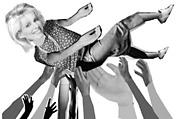LET’S FACE IT: The Pike Place Market is a confusing riot of foodstuffs and trinkets, and even on a good summer day—defined as one in which flocking tourists aren’t standing between you and a pound of asparagus—the sheer mass of product choices can be overwhelming.
Still, becoming a Market regular or simply getting good food there doesn’t take a bucket of cash or even an ounce of skill. All it takes is some time, a little education, and a yearning for some of the best fresh food the Northwest has to offer.
First off, you need to get your bearings. The Market sprawls over a dozen rambling—and ramshackle—buildings and arcades. “The best thing to do is to stop at the Market information booth and get a merchant map,” says Sue Gilbert Moores of the Preservation and Development Authority. “You can also ask merchants or pick up a copy of the Market News, which also has a map.” Part of the fun of the Market, of course, is just wandering around looking at stuff. After a few visits, certain landmarks start to stick out. But all you really need to know is north and south and Rachel the Market Pig.
OK, now that you know where you are, let’s find out where you’re going. Any true Market regular can tell you how to find good food at the Market. But the real secret isn’t who has the best tomatoes or the nicest cut of fish. It’s who offers you the best experience of buying tomatoes and which fishmonger has the cleanest pants.
To get a handle on this more pressing issue, I asked a handful of chefs, vendors, and regulars for their best piece of advice on Market shopping. Two distinct approaches came to light: the Wandering Approach and the Strategic Approach.
Michael Maria, assistant manager of Sur La Table, a kitchen emporium on Virginia between Pine and Stewart, takes the Wandering Approach. “I start by taking a walk through the low stalls to see what’s fresh,” he says. “Then I traverse back to the high stalls for more regular produce.” High stalls, between Rachel and City Fish company in the main arcade, are permanent vendors who often get their produce from wholesalers. Low stalls, south of City Fish, are occupied by day vendors who grow the food themselves. If you want locally grown produce, check out the low stalls for what’s in season. For everything else, the high stalls are best.
The Wandering Approach permits a broad survey of the selection for those seeking either a specific product or the best price. Mariam Jacobi, one third of the Three Sisters in Post Alley, is a dedicated Wanderer. For their daily selection of grilled European sandwiches and soups from around the world, Mariam and her sisters Aruna and Nirala take a basket from one end of the Market to the other. “We look at what’s on sale, what’s in season, then we make up the recipes.” Miriam recommends shopping on Wed-nesday. “That’s organic day at the Market. Outside the main arcade, organic farmers sell their produce. It’s very good, healthy.”
OTHER MARKET-GOERS opt for the Strategic Approach. After years of Market shopping, price comparison, and evaluation, they have identified certain key vendors from whom they buy their fish or produce. The benefits of this approach can range from spur-of-the-moment discounts to an emotionally rewarding relationship with the guy packing your fish. For months after moving to Seattle, my biweekly solace was Rita at Manzo Brothers, in the main arcade. My first visit with her was unremarkable, but on my return, while I was pondering cantaloupe, she leaned over a display of Brussels sprouts and said, “Whatcha need, dear?” Enraptured, I just handed her my shopping list. She picked out the finest Roma tomatoes, the greenest string beans, the nicest head of lettuce. . . . It was as if Mom was doing my shopping for me.
Scott Masoner, head cook at the Alibi Room, gets good deals from Frank’s Quality Produce on the corner of Pike Street and Pike Place in the Sanitary Market Building. For fish, he likes Pure Foods (south of Rachel in the Main Arcade), not only for good quality and good price, but because they often carry a selection of exotic fish. And DeLaurenti’s in the Economy Building is his hands-down choice for best retail imports and specialty foods.
One of my favorite fishmongers is City Fish Company (south of Rachel, where the high stalls abut the day vendors). Although they don’t carry the exotics as often as Pure Foods, their stall isn’t surrounded by tourists the way Pike Place Fish Company is, and the only thing thrown at City Fish are slit-open tennis balls, used to pass customer change back and forth.
The guys who work at City Fish also embody a Market spirit that makes it easy to be a regular. They’re knowledgeable about their product and go about their business in a friendly and open manner. Johnny Patnode has been working at City Fish for five years and has some good advice about shopping at the Market. “Don’t shop on an empty stomach,” he says. “Look for fish with bright eyes and shiny scales. Make sure the vendor’s fish pants are clean. Ask questions.” Then, a little more sternly: “Don’t touch the merchandise. That’s somebody else’s dinner.” Amen.
NOW THAT WE’VE covered the art of Market shopping, there’s another side of Pike Place that’s equally rewarding to the gastronome: the restaurants. No Market trip is complete without a nosh, and knowing just the right place is key to your complete education as a Market regular.
Down two flights of stairs from the main arcade, past the Market office, the Alibi Room is enshrouded in enigma. I went there one day with Avram, a Seattle artist and self-described Ally McBeal addict. The bar and the main sitting area are separated by a false wall that sports art and a blackboard listing various specials. Avram and I sat at one of the tables by the windows offering a view of Elliott Bay and West Seattle. The floors and ceilings are rough hardwood, and the white-clothed tabletops each have a slender glass vase containing a long-stemmed, frayed tulip. The laid-back staff is unpretentious, swanky, and cool. It’s the perfect place for an early afternoon cocktail and cigarette.
Avram and I split the crostini appetizer and the roasted veggie plate. One of these would have been enough. The crostini came with a tangy sun-dried tomato paste, a creamy artichoke dip, and a chunky fresh pesto. The roasted veggie plate held three piles of roasted red peppers, mushrooms and onions drizzled in balsamic vinegar, and a mellow blend of zucchini and yellow squash. The flavors were subtle and played off of one another nicely. We washed it all down with a brandy Manhattan, a little on the sweet side, but yummy nonetheless. The tab for two with drink was around $25.
I also recommend Copacabana, at the south end of Post Alley, when the weather is good. (Don’t let the Barry Manilow connection scare you.) They serve the best Bolivian cuisine in Seattle, and their outdoor dining area sports a fabulous view of the Market and the Sound. The service can be a little erratic on the weekends and there’s often a line, but if you order a glass of sangr�and melt into the warm sunshine and the cool breeze coming off the water, you won’t mind.






